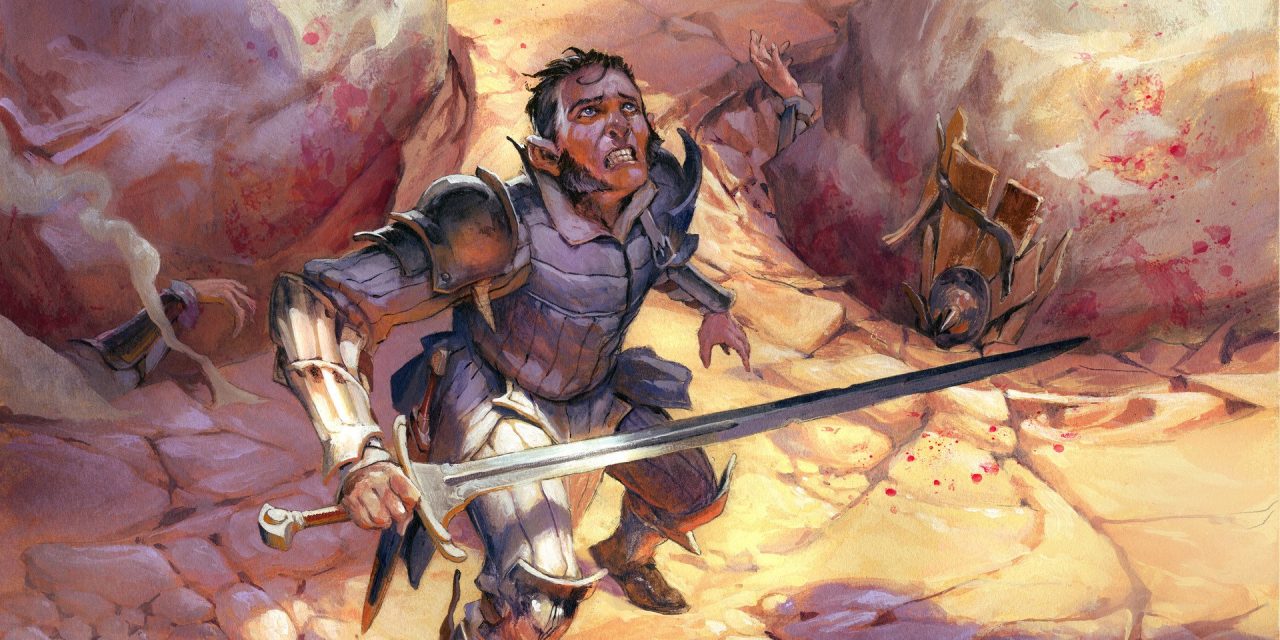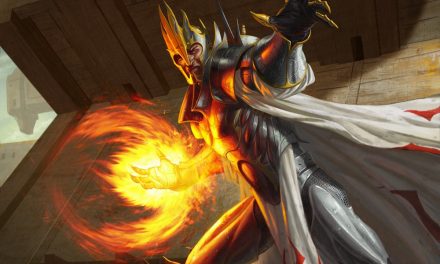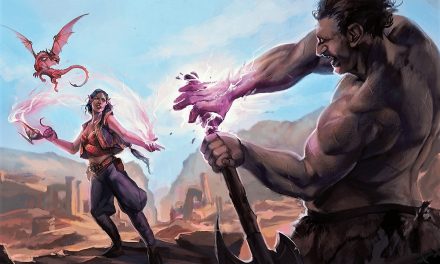Combat in D&D 5e is where most of the thrill, urgency, and legendary stories can be found. It’s typically signaled by the Dungeon Master saying those famous words, “roll for initiative!”
But what exactly is combat and how do you know what to do on your turn?
Today we take a look at just that!
The Order of Combat in D&D 5e
To simulate the intensity of combat but keep it manageable for the DM and players, combat is broken down into rounds and turns. A round includes everyone in the initiative order (which we will get to shortly) and represents 6 seconds of action. Within each round, combatants act on their turn in the initiative order.
Surprise
It is possible that the party has decided to ambush enemies or is being ambushed themselves. Because of this, determining if anyone is surprised is the first step in a Combat encounter. If neither side of the combat encounter are trying to sneak up on the other, there is no surprise round.
Since this guide is meant to be for beginners, we’ll cover Surprise in more depth in a different article that you can read here!
Initiative
All participants in the combat roll for initiative. This determines the order of combat.
Initiative is found by rolling a d20 and adding your dexterity modifier to the result. Some feats or magic items may give you bonuses to initiative, but we’ll just do a d20 plus your dexterity modifier for now.
Let’s say Julius, the Monk, rolls a 15 on his initiative. He adds his +3 dexterity bonus from having a Dexterity Ability Score of 16. Julius will go on initiative count 18.
Dagnarus, the Paladin, rolls an 18 on his initiative. With a Dexterity score of 8, Dagnarus has a -1 penalty to his Dexterity checks (including initiative.) Adding the -1 penalty to his roll, Dagnarus goes on initiative count 17.
Side Note: Learn more about ability scores and modifiers by checking out this article on Ability Scores.
What If There is a Tie for Initiative?
In the event of an initiative tie, an order has to be established.
If the DM’s creatures tie, the DM decides the order. If two players tie, they may decide the order themselves.
Alternatively, the DM may have the tied combatants each roll a d20 with preference going to whoever rolls the highest. This is especially common if a player character ties with an enemy creature.
The party’s Bard, Lenore, has tied for initiative count 10 with Bolt, the party’s Ranger. Lenore plans to use the Faerie Fire spell which will greatly help Bolt hit his target, so Lenore goes first.
Lastly, there is a tie for initiative count 6 between Niri, the party’s sorcerer, and the enemy gnolls.
Niri and the group of gnolls (who are all on the same initiative count) each roll another d20 with no bonuses. Niri rolls a 12 and the DM rolls a 17 for the gnolls who will now be going before Niri.
Establishing the Turn Order
The DM or a very helpful player write down the initiative order.
In this case, the initiative order goes as follows:
Julius goes on 18.
Dagnarus goes on 17.
Lenore goes first on 10.
Bolt goes second on 10.
The enemy gnolls go first on 6.
Niri ends the round by going second on 6.
These initiatives last through the end of combat when the enemies have either been slayed or successfully run away. (Or if the party does the same, but, you know, we’ll keep it positive!)
Taking Turns in Combat in D&D 5e
Each player takes their turn in the initiative order.
Each turn is made up of an Action, a Bonus Action, and a Movement. These do not have to be in a set order.
For example:
Lenore casts Healing Word (which only requires a bonus action as we’ll detail later in this article) to heal the wounded Paladin, Dagnarus. She uses half of her 30ft of movement to run up to the enemy gnoll that is 15ft away and uses her Action to attack with her rapier. She hits, rolls damage, and slays the monster before using her last available 15ft of movement to join Julius standing beside another gnoll.
With this done, Lenore ends her turn and it becomes Bolt’s turn.
We’ll cover the available Actions and what they mean in the next section.
Beginning the Next Round
Once everyone has taken their turn, the 6-second round comes to an end. The next round begins back at the top of the initiative order. This process repeats until combat comes to an end.
Combat in D&D 5e – Actions on Your Turn
As mentioned previously, a standard turn is made up of an Action, Bonus Action, and Movement Action.
But what do those mean?
Movement
You character’s race and class determine your movement speed. Other things (like spells, feats and magic items) may affect this, but we’ll keep it simple for now.
The standard character has a movement speed of 30ft per round. Smaller races, such as gnomes or halflings, commonly have a lower movement speed of 25ft. Some classes (like the Monk) give bonuses to movement speed.
Like Lenore in the previous example, a character can split their movement. The movement speed only represents the maximum that the character can move without using the Dash action, which we’ll describe below. You don’t have to use all of (or any of) your movement.
Actions
Actions are exactly what it sounds like: the primary thing you do on your turn. There are several options available to you, so there’s never a situation where you need to “skip” your action!
Attack
Attacking is when you… well… attack something. Using a melee or ranged weapon, you roll your d20 and add any bonuses to the result. If your attack roll meets or beats the target’s Armor Class, you successfully hit and roll damage.
Classes like Fighters, Monks, and Barbarians get abilities that let them attack multiple times in one Action!
Cast a Spell
Most spells require one action to cast. There are some exceptions that only take a bonus action and some that may take several minutes to an hour to cast, but most only take the one action.
Casting a spell, you do as the spell description says. Some may require a ranged spell attack roll while others may require the target or targets to make a type of saving throw.
Side note: For a quick way to reference your spell effects, check out our review of the D&D 5e Spellbook Cards!
Resolve the spell effect and end your Action.
Dash
“What if the enemy is 60 feet away from me? “you may ask.
This is where the Dash action comes in handy!
Using the Dash action, you can move again up to your movement speed.
So if Dagnarus, with a movement speed of 30ft, chooses to Dash, he is able to move a total of 60ft this round.
Whether you choose to use this Action for running into combat or running away, it’s a useful one to know!
Disengage
The Disengage action is used to safely get away from an enemy.
Typically, moving away from an enemy can open you up to getting hit by their Attack of Opportunity. (Which we’ll also cover in a later article.)
Using the Disengage action, Niri, the squishy sorcerer is able to freely run away from the gnoll that is right in front of her. This helps her to get better positioning in the fight as well as avoid getting hit.
Speaking of not getting hit…
Dodge
If you don’t want to leave your current space but you’re also worried about getting hit by the creature in front of you, you’ll want to take the Dodge action.
By completely focusing on avoiding the enemy’s attacks, their attacks against you will be at disadvantage.
Similarly, if you need to make a Dexterity saving throw (like if a fireball comes your way), the Dodge action gives you advantage!
You can learn more about what that means in our article explaining Advantage and Disadvantage in D&D 5e!
Help
Using the Help action in combat can be a little tricky.
Rather than attacking, you serve as a distraction for the enemy. The enemy has to be within 5ft of you and you declare which ally you are “Helping.” Until the start of your next turn, that ally’s first attack against the distracted enemy will be at advantage.
In situations where you are unlikely to meet or beat the enemy’s Armor Class, the Help action can be great for setting up your party’s heavy-hitter to bring the hurt!
Hide
A favorite action of Rogues, the Hide action lets you attempt to conceal yourself from an enemy. The enemy must roll a Perception check versus your Stealth roll to attempt to see you. If they fail, they will likely move on to a different target and possibly open themselves up for a nasty surprise from you next round.
Fans of Critical Role will recognize this action as being used often by the group’s Rogue, Vax’ildan.
Ready
You know what you want to do, but the timing isn’t quite right.
The Ready action lets you set a trigger for some Action. This trigger lasts until the beginning of your next turn.
Think of it as an “if-then” statement.
“If the giant spider comes down to try and bite me, then I’ll swing my axe at it.”
Or
“If the orc steps on the trapdoor, then I’ll pull the lever to drop him”
This can be an especially dangerous action when taken by strategically-minded spellcasters who want to ready a spell like Fireball. Be warned, however, that readying a spell still uses the spell slot whether or not the specified trigger occurs.
For example:
Niri readies a spell. If three or more goblins group up,then she’ll cast the Fireball spell.”
The goblins do not move together and instead begin to scatter after various party members. Niri crosses out a 3rd level spell slot for the Fireball spell that was readied but not cast.
Ouch.
Search
In some situations, it may be necessary to Search for something in combat. By taking the Search action, the Dungeon Master may ask you to make a Perception or Investigation check as appropriate. Upon success, you just may find what it is that you’re looking for.
For example, let’s say that the party is fighting some attacking enemies in a large room. You notice that the room contains four trained mastiffs in large iron kennels. Rather than fighting the enemy head-on, you may notice that all of the kennel doors are operated by a single pulley.
Hmm…
By using the Search action, you can attempt to find the lever that controls the pulley. The Dungeon Master asks you to make a Perception check. You roll and add your modifiers for a total of 23! Success!
Upon finding and pulling the lever, the four mastiffs come running out of the kennels to assist the party in fighting the enemies. Now that’s some quick thinking!
Use an Object
Going off of the previous example, it may have been easy enough to pull the lever that you didn’t need to take an additional action to operate it.
But what if the lever is in major need of oil and hard to pull?
This is where the Use an Object action comes in.
This is for objects that require your full attention to use. Something like the previously mentioned lever or applying poison to your weapon are examples of things that would require taking an Action to perform.
Drinking potions typically counts as an action as well, but as we covered in our article on 10 Optional and Homebrew Rules for D&D 5e, this might not always be the case!
Bonus Action
Some spells, class features, and abilities take a bonus action to pull off. These abilities can only be used as a bonus action and not in place of an action.
For example, Lenore, the bard, cannot use her bonus action to cast the Healing Word spell and use her Action to use her Bardic Inspiration ability (which also takes a bonus action.)
She could, however, cast Healing Word then do one of the other actions that we’ve covered such as Attack, Dodge, or attempt to Hide.
Reaction
Reactions are most commonly used for taking Attacks of Opportunity against enemies. However, there are some spells and special abilities that use a reaction to work.
The most common example of this is the “Shield” spell which allows the caster to use their reaction to cast the spell and gain +5 to their Armor Class.
Reactions are typically things that happen in those clutch, just-in-time moments.
And That’s Combat in D&D 5e
You made it!
This is the complete guide to Combat in D&D 5e.
Ok, it seems like a lot and I guess it is. But once the dice start rolling and you see these mechanics for yourself, you’ll see that it’s actually very quick and smooth!
Be sure to subscribe to the Tabletop Joab newsletter so that you don’t miss a single thing as we release new content regularly!
Still have questions about Actions or Combat in D&D 5e? Let us know in the comments below!









